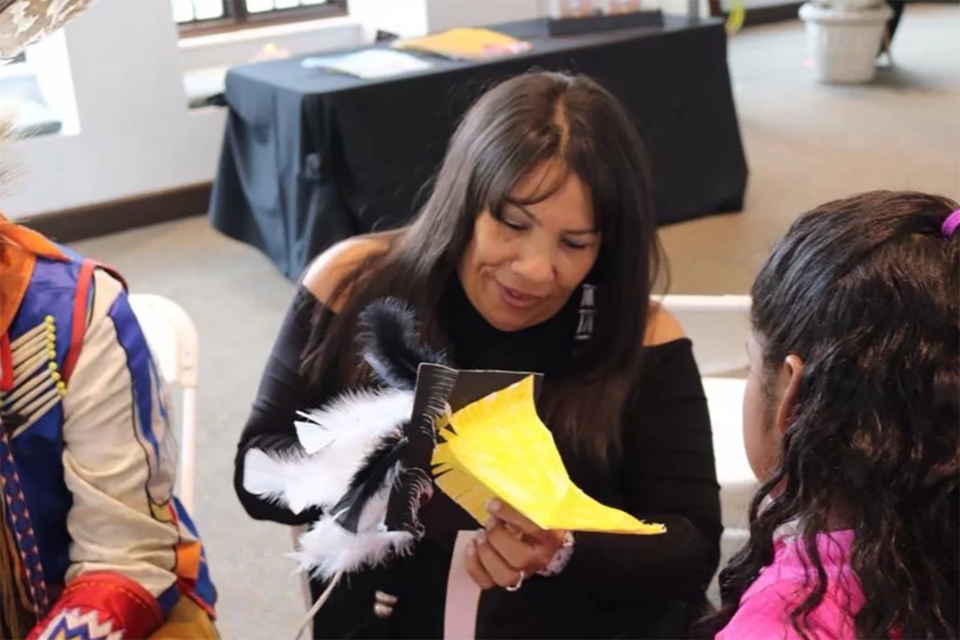KEHEWIN – Known throughout the Lakeland for storytelling, dance and theatre productions, Kehewin Native Dance Theatre (KNDT) is branching out into the world of music production to offer local Indigenous youth the opportunity to express themselves through song.
In January, the KNDT learned that a collaborative project they pitched was one of 11 projects selected by the Bell Let’s Talk Diversity Fund.
The theatre group was award $100,000. The funds must be spent over two years to carry out the youth-focused project aimed at reducing the stigma of mental illness and increasing access to culturally informed mental health and well-being support for Indigenous teens.
KNDT will be working with the Canadian non-governmental organization (NGO) Make Music Matter based out of Toronto, and the National Music Centre in Calgary, to make the Naskwahamâtowin Project a reality.
In an interview with Lakeland This Week, Rosa John, the artistic director of KNDT, explained the Naskwahamâtowin Project and the meaning of its name. It “means let's all share the music or singing together,” she said, adding the project is about giving a voice to Indigenous youth and creating an artistic outlet for expression and healing.
“Along with our partners Make Music Matter, we will offer new and innovative arts-based programming to address a lack of mental health support in our community, help amplify Indigenous voices, and fuel critical conversations on local, national, and international levels,” said John.
The Naskwahamâtowin Project will follow a framework created by Make Music Matter, using music and song writing to provide a unique form of group therapy for people who have experienced a wide range of traumas.
The NGO’s Healing and Harmony program uses trained therapists and music producers to work in tandem as participants begin the healing process by writing, recording and professionally producing songs about their emotions and experiences.
“We have come together with them, and we will develop the same thing but to fit our Indigenous community here,” added John.
The collaboration will allow the Naskwahamâtowin Project to combine the therapy model with Indigenous music, languages, and culture to help address the mental health crisis in the community and other devastating effects of intergenerational trauma and its impact on Indigenous youth.
“It’s our hope that this collaboration could help establish a new framework for trauma-informed mental health support through the arts for marginalized groups across Canada,” stated Darcy Ataman, Make Music Matter founder and CEO.
Ataman will be visiting the community on Feb. 27, as facilitators and coordinators of the project come together to prepare and train before the Naskwahamâtowin Project officially gets off the ground.
Included in that training will be local therapists, some of which have already worked as emotional support workers on KNDT productions.
“We always have to have that support,” said John. “A great part of this project is that we're going to be working with the therapists that are already in the communities. Therapists who already know the community, know the community members, and so they too will get training for this Healing in Harmony program.”
All the while, KNDT will be utilizing funds from the Bell grant to purchase a portable studio and fill it with modern equipment for music production.
“We haven't done anything like this since 2007,” said John. “All our studio equipment is ancient. So, this is great and it's also going to be portable so we can go to the communities, and nobody has to come here.”
The project will also have a regional approach.
KNDT is looking to form partnerships with seven schools in seven different communities to find participants for the project. The teens chosen will work over the spring and summer to create a collaborative song that will ultimately be produced and mixed by the National Music Centre.
Youth will work on lyrics, harmonies, vocals and music in small groups, with the goal of releasing a track by the end of July.
“The song that they're all going to create together will take place at different times, but that song is going to get put together and it's going to be dealing with a lot of the issues that young native people are dealing with right now,” John explained.
Having a voice
For John, the most important part of receiving the grant and having the ability to carry out the Naskwahamâtowin Project is being able to give a voice and a platform to youth.
“If you have seen one of our shows, most have scenes in it about residential school, the effects of residential school, the effects of centuries of colonization, child welfare programs, intergenerational trauma. All of these things are totally integrated into everything that happens in our community,” said John.
“We discovered that through our dance and theatre - and that's so important - is for the youth to have a voice because when they don't have a voice and when they don't know how to share what they're feeling – that's when problems evolve.”
John continued, “One of the ripple effects that I see is getting youth used to feeling like leaders. They have to feel like stars, they have to feel like ‘I'm somebody’ because for so many years Indigenous people have been nobody.”
While participants work with therapists and producers, she hopes the kids will begin to recognize “they are somebody – they are somebody with feelings, they are somebody with hope, they are someone with a voice – for me, that is a ripple effect.”
John hinted that when the song is ready to be released later this year, members of the public can expect a big release event in Kehewin or Bonnyville.



